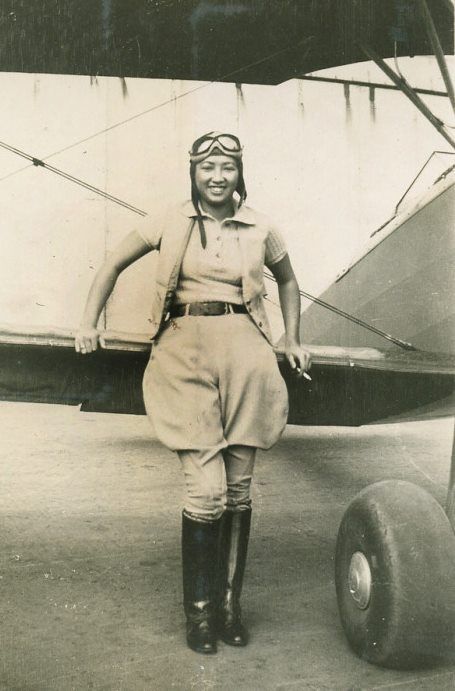
Hazel Ying Lee was a Chinese-American who has been described as being bubbly, fierce and optimistic. Born and raised in Portland, Oregon, Lee had only one dream: to fly.
Since she was a teenager her eyes were set to the sky as she fantasized about being amongst the clouds. Her determination and resourcefulness manifested that dream into reality. From 1932 to 1944, Lee flew a wide variety of planes, ranging from commercial aircraft to high-powered fighters for the United States military.
She did so, with great aptitude, until a control tower in Minnesota confused her aircraft with another while she was attempting to land. This mistake resulted in an explosive collision with another plane that left her severely burned and hospitalized. She died two days later.
Born August 24, 1912,Lee was the second of eight children. Described as a fearless, adventurous tomboy growing up, Lee caught the flying bug when she got the chance to ride along with a male friend taking flying lessons. By this time, she had graduated in 1930 from Commerce High School, now Cleveland High School, and used her earnings as an elevator operator at Liebes Department Store to pay for flying lessons.
At 19 she was sailing the skies in a program sponsored by the Portland Chinese Benevolent Society. Lee then became the first Chinese-American woman to earn her pilot’s license in October 1932.
Lee had noteworthy flying abilities and a good-natured personality, according to the Federal Aviation Administration and fellow WASP pilot Alice-Jean M. Starr. Despite this, governments were not willing to take her on as an official military pilot due to her gender.The first instance of this came when Lee—along with other Chinese-Americans—went to China in 1933 to aid in the war against Japan.
The Chinese military did not see her value and rejected her as a military pilot. To make ends meet she got a desk job and occasionally flew commercial planes in Shanghai. She tried again to fly for the Chinese military in 1937 but was turned down for a second time.
She came back to the United States in 1938 and lived in New York with a job purchasing war materials for the Chinese government. It was not until 1942 that Lee applied for, and was admitted into, the newly formed Women Airforce Service Pilots.
WASP was a combination of two separate programs that were created by aviatrix Jackie Cochran and an entrepreneur named Nancy Love. The goal of WASP was to free up as many men as possible to be sent overseas for war time.
According to the WASP Museum’s website, pilots of the program performed a variety of aviation-related jobs. The museum states on their website that ”WASP flew every aircraft in the Army’s arsenal. In addition to ferrying, they towed gunnery targets, transported equipment and non-flying personnel, and flight-tested aircraft that had been repaired before the men were allowed to fly them again.” Because the women were first to fly the aircrafts they were often the first to discover flaws and poor manufacturing quality.
However, before Lee was able to get her hands on the latest flying technologies, she first had to go through training in Sweetwater, Texas in 1943. She was not shy about her heritage or culture during her training and was happy to educate her fellow pilots. She even took to inscribing nicknames on each one’s plane in Chinese characters using lipstick.
“She was in our room more than she was in hers,” said A.J. Starr, former WASP and friend to Lee. “She would come bouncing in, laughing, with the latest information or joke. She was always very jolly.”
After completing her training she was then stationed at Air Transport Command’s Romulus Army Air Base in Michigan for a time but then went to Pursuit School in Brownsville, Texas in 1944. This schooling made her one of 132 women qualified to fly high-powered, single-engine aircraft.
Some of the planes she flew were the Boeing C-47, Republic P-47 Thunderbolt, Bell P-63 Kingcobra and the North American P-51 Mustang. According to Women in Aviation International, the P-51 Mustang was her favorite. During that time she, along with other pursuit pilots, ferried upwards of 5,000 planes for military use to Great Falls, Montana. This supply chain went up to Alaska and was crucial in supplying Russian allies.
Although Lee had accomplished her dreams of flying planes for a living, the job took its toll. In one of Lee’s final letters to her sister she wrote about the exhausting nature of working every day of the week with little time off. According to Montgomery Hom, the co-producer of “A Brief Flight: Hazel Ying Lee and The Women Who Flew Pursuit,” Lee wondered what would happen to her.
On November 10, Lee attempted to carry out orders to pilot a P-63 to Great Falls, Montana from Buffalo, New York. Her flight had been delayed due to weather conditions, however. When it finally cleared she took to the skies.
By the time she would arrive, the amount of P-63s coming into Great Falls created confusion within the control tower. They’d mistakenly instructed Lee and another pilot to land at the same time, with one plane flying just above the other. Control tower operators realized the mistake and told the plane on top to quickly pull up. Unfortunately, confusion persisted and they’d actually told the bottom plane, Lee’s aircraft, to go up.
A collision, explosion and crash. After being pulled from the wreckage, Lee was hospitalized due to severe burns for two days before succumbing to her injuries. She died on November 25, 1944 and was the last of the WASPs to die on duty as the program was ended the following month.
Lee’s parents were notified of their daughter’s death just a few days before hearing about their son, Victor, dying in combat in France. Initially, her parents were denied the right to bury their children at Riverview Cemetery in Portland due to being non-whites but after fighting against these rules they were permitted.
In addition to racism, Lee, along with the other WASPs, had to deal with the sexist decision to not be considered military veterans. According to the Federal Aviation Administration, WASP pilots were classified as civilians; they were required to buy their own uniforms, pay for their lodging out of pocket and were not given military benefits or funerals.
This was all on top of being paid less than their male counterparts. It would not be until 1977 that President Carter would give veteran status to the WASPs. President Obama gave Congressional medals to them in 2010. Oregon inducted Hazel Ling Yee into the Aviation Hall of Honor in 2004.



